As an Amazon Associate I earn from qualifying purchases.
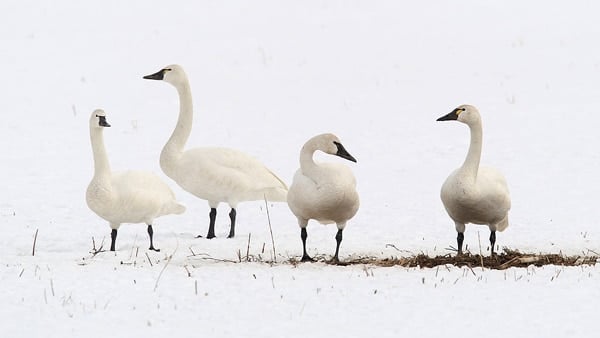
A few years ago in Utah, under the shadow of the Wasatch Front on Great Salt Lake, I hunted and killed a tundra swan. Two years later I hunted and shot black swans near Christchurch, in New Zealand. Now I could write about these hunts as if they were any other, but that would ignore the simple fact that in Western culture hunting and eating swans is something of a fringe activity, to put it mildly.
Shoot a goose and people ask you how you’re going to cook it. Shoot a swan, which, after all, is essentially a long-necked goose, and people ask you why you’d want to do such a thing. This is understandable. You can’t just pick up a pack of swan breasts at your local Safeway and only six states allow swan hunting, so it’s unlikely that even hunters know much about these birds. Again, unlike geese or ducks, swans are not creatures we automatically place into our mental “food animal” buckets.
But neither are a lot of perfectly edible animals, like, say, woodchucks. Swans, however, are not woodchucks. Few animals are so loaded with cultural baggage as are swans. For starters, Leviticus 11:18 bans the eating of swans as “unclean,” which I find ironic considering that it is a mute swan that’s the medieval symbol of love. Mute swans also make an appearance in “Swan Lake.” and the “Ugly duckling,” and a swan is the national bird of Denmark. Exactly how swans went from unclean to symbols of love isn’t clearly understood.
One reason could be because swans are visually striking. Trumpeter and mute swans are the largest flying birds in North America, weighing upwards of 33 pounds; the tundra swans we hunt, by comparison, are a dinky 17 pounds on average. Incidentally, it is the mute swan that we mostly see in parks. It’s a European native brought over in the 19th century that happens to compete with the trumpeters for habitat. Black swans (Cygnus atratus) are just as striking, weighing about 18 pounds with charcoal feathers and a bright red bill.
I can hear you saying, “Oh, but swans mate for life!” Yes, they do. But then again so do turkey vultures. And “mating for life” has been shown to be a fallacy even in the bird world; scientists have recorded “divorces” and cheating among supposed life partners. But still, I get it: Even if the reality is mundane and base, the swan, idolized of course, makes for a majestic symbol of faith, beauty and love. I used to work in politics, and in that realm it is a truism that perception is reality.
Interestingly, however, since my hunt I’ve been getting the “Oh God, how you could kill a swan?!” reaction a lot less than I’d expected. I suspect this is because a great many of us have had personal experience with mute swans in parks. For every negative reaction I’ve received, I’ve had at least two people recount to me their version of having their idyllic notion of swans broken by a giant, hissing monster that chased them around as a child. All I wanted to do was feed it bread — and it bit me!
The most common response to me has been a sidelong look, as if to silently wonder whether I’ve become Hunter Angler Poacher Cook. So for the record, everything about my swan hunts was legit. In Utah, you must take a test to even apply for a permit, then you need to be lucky enough to draw one of the 2,000 tags, and if you are so lucky, as I was, you only get one bird a year. In New Zealand, where I was hunting, the bag limit was 5 per day.
And in Utah, if you get a swan, you must immediately check it into the local Fish and Wildlife office so they can mark your tag — and be sure you did not shoot a trumpeter swan, which although not technically threatened is still in low numbers even a century after hunting trumpeters was banned. In Utah, if hunters kill 10 trumpeter swans, they close the whole season down. So far, it’s never happened.
On a typical year, somewhere between 35,000 and 50,000 tundra swans congregate on the Great Salt Lake. November is prime time for swan hunting, and as it happened, my book tour took me through Salt Lake at the perfect time. So I teamed up with my friends Matt and Steve from Camp Chef, as well as Jeff Bringhurst and Tony Smith; I’d hunted ducks with all of them the previous year.
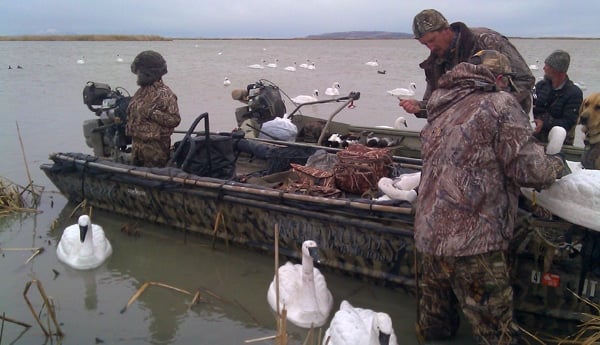
Watch the video for the full experience, but suffice to say it was a little like duck hunting, a little like goose hunting. We motored out with a few huge sacks of swan decoys, and set them out in thigh-deep water just like a duck spread. This was very much different from the massive goose spread we put out for specklebelly and snow geese last week. Five of us had swan tags we were eager to fill.
Now no one manufactures a swan call, but they are remarkably easy birds to call in by voice: “HOO! WHOOP!” shouted in the right tone really does approximate what a tundra swan sounds like. And these Utah boys knew the right tone. It didn’t take long for the first swans to come in.
Any duck hunter who has watched swans lazily fly overhead can see how slow they fly… only they’re wrong. This is an optical illusion. Swans are so large and they get so far with each wingbeat they only appear to be slow. Get this: The maximum recorded speed for a tundra swan was an eye-popping 83 miles per hour! That makes a canvasback look slow. I tell you this because we were all horribly behind on our first shots.
I looked at Matt, and he looked at me: “Guess we need to lead ’em a lot more.” Fortunately we got another chance soon. This time it was a pair of swans, and as they came closer it was obvious that one was a juvenile; juvies are splotched with gray feathers and are markedly smaller. Everyone knew I was hunting specifically for the table, so they let me take a crack at the young swan. Jeff called the shot, I rose up and rocked the swan with the first shot, quickly realized I needed even more lead in front of it and fired again. A wing cracked and the swan fell, head down, splashing like a bowling ball in a swimming pool.
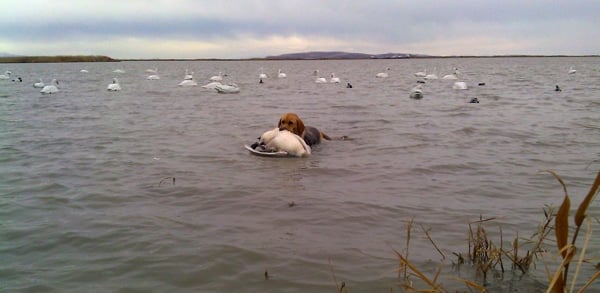
Both swans had gone down. And as the dog retrieved them, I could see how much larger the adult was: Easily 5 pounds or more larger, and a foot’s worth of wingspan. I didn’t care. I was happy to put my tag on the juvenile, which by all accounts would be the best eating.
And by all accounts, I mean all. There is a surprisingly large body of literature on the eating of swans, most of it from Britain. Swans were legitimate table fare in the UK up until the late 1800s; it was a luxury bird reserved for special occasions or for royalty. Queens Elizabeth and Victoria reportedly ate cygnets for Christmas dinner — a cygnet is another word for a juvenile swan — and by acclamation were wonderful eating. Every reference I could find about swans as table fare stressed the need for a young swan. Older swans are said to taste like “fishy mutton.”
Back home, I bent to the task of plucking my swan. This took a while. And I was not about to skin what might be the one and only swan I’d ever eat. I wanted the full experience: fat, skin, meat, giblets, everything. Once plucked, the bird looked like a cross between a snow goose and a Canada goose. Pale skin, ivory fat, and not a ton of it. As I broke the bird down (no way I would try to roast a swan whole!), I kept mentally remarking how, well, unremarkable this bird was. Really no different from a Canada goose, only with a really long neck.
Holly and I waited to serve the swan until Christmas dinner. Seemed fitting. The wingtips, neck meat, feet and giblets all went into a wonderful German soup called ganseklein, a recipe for which is in my new book. (German-speakers would say I made schwanseklein…)
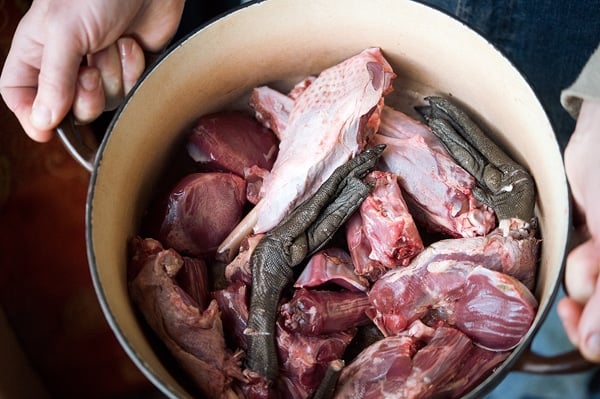
The main course was the breast pan-roasted to medium-rare, with wild cranberry chutney and leberknödel, liver dumplings made from the swan’s liver. The legs we ate the next day mixed into some fried rice.
The verdict? Swan is, oddly, more like duck than it is like goose. In fact, the closest thing I can compare it to would be canvasback duck: Dark, tender, mild and clean-tasting. It did not have that toughness Canada goose breast can have, nor that beefiness that many geese possess. Gotta say I like it. But it still doesn’t compare to a specklebelly goose, which retains its position as the World’s Finest Waterfowl, at least to my palate.
Would I shoot another swan? Sure. If I happened to be in Utah, Nevada, Montana, South Dakota, North Dakota, Virginia or North Carolina during the season, I’d apply for a tag. But I am pretty certain I would not go on a special trip just for swans. Specklebelly geese? Now that’s a different story.

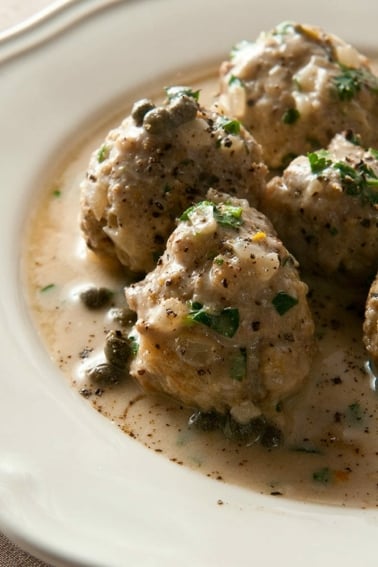
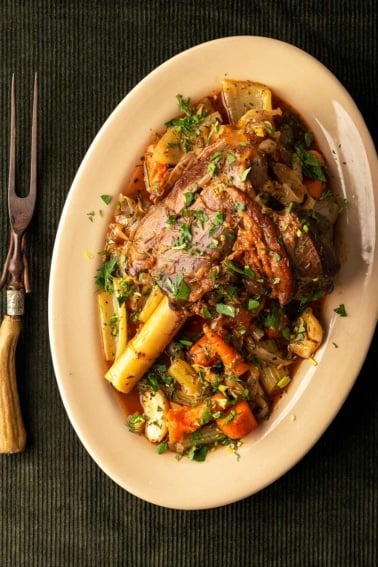
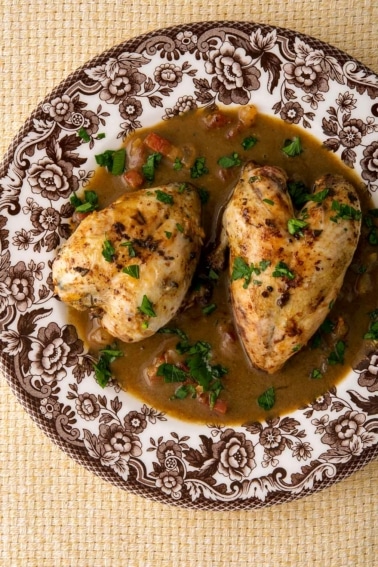
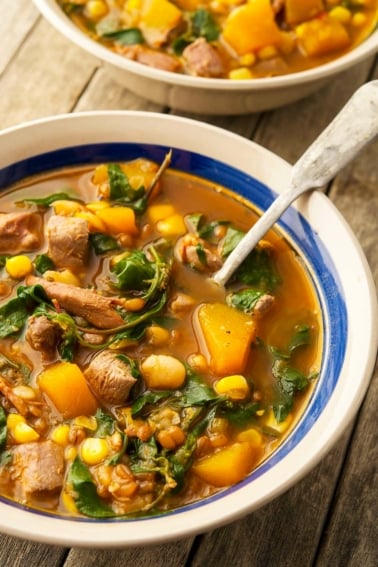
I’ll admit, when I first started reading, I was taken aback. (I was just looking for information on swans because I like to draw animals and learn about them. When I saw the title for the article, my curiosity peaked.) I tried to open my mind however to see where the article was going, and actually found it quite interesting. The awareness you have around the societal perceptions of the animal–and the animal itself–shows that you have a deeper understanding than one might assume you have. I actually appreciated the story and it opened my own awareness of hunting in general I think.
Hello Hank,
I made a reference to you and to your website on my thread “Ontario Tundra Swan Season” that I posted on the Long Point Channel 68 “waterfowl” forum as well as on the Hunt Ontario “waterfowl” forum. I am sure that many individuals in Ontario will enjoy viewing the contents of your website.
Jerome Katchin, D.V.M.
Port Rowan, Ontario
Virginia they’re a nuisance species you don’t need a tag. Enjoyed your article.
Hello Hank,
I have had several individuals ask me about cooking a Tundra Swan as well as how it would taste … if we were ever to get a linited (tag only) Tundra Swan season in Ontario at some point. I thank you for your general comments regarding Tundra Swan hunting and for your recipe.
However contrary to what was posted on this website a Tundra Swan call was (still is) available from DJ Calls for $59.95 US (plus shipping) at the time that I bought mine in 2012 (definitely more now). An instructional CD is also included in the cost.
Jerome Katchin, D.V.M.
Port Rowan, Ontario
thanks for all the info. I’m in Jersey can’t hunt’em but there gettin outta control, in just the last few years. guess i have to raise hell @ the State House
about a Swan Hunt Season. thanks again
Tom
I did some research years ago on that “swan” listing in Leviticus…especially since ducks and geese are considered clean. The word from the original Hebrew is “Tinshemeth”, which refers to a small Palestinian owl, not a goose. For whatever it is worth…)
Pan fried Royal Swan and sautéed Ruby Throated Hummingbird tongues are to die for, absolutely delicious. However, when I’m visiting friends in the South of France, I love to gobble down those delectable ortolans, sans the head napkin nonsense. Or in the words of my boon companion Andrew Zimmern IF IT’S TASTY EAT IT.
Found this by chance. Interesting article. Have a thing to point out, though.
“For starters, Leviticus 11:18 bans the eating of swans as “unclean,” which I find ironic considering that it is a mute swan that’s the medieval symbol of love.”
You talk as though Western culture started with the Bible. I am sorry to contradict you, but as a historian (and a Brit) I need to point out that swans figure imposingly in classical culture, where many of the roots of ours are set. Swans were sacred to the Greeks and Romans, in particular they were sacred to Aphrodite/Venus. Zeus conceive Helen and her brothers and sister in the form of a swan, and Leda delivered them inside eggs.
This is why in our culture swans are still symbols of love (also thanks to Shakespeare’s Juno’s swans in As You Like It, even if he mistook Juno for Venus).
The Leviticus has not influenced much of our collecting habits regarding unclean animals or fibres that should not be mixed. Classical myth has influenced much more.
Swans are symbol of love because when they ‘kiss’ their bodies (necks and heads) are forming shape of a heart.
I don’t see why it should be illegal to hunt mute swans in any state of the US. They’re an invasive species.
Very interesting! Strange to hear that the taboo against swan hunting exists elsewhere. Hunting of swans is illegal in the UK, as they technically all belong to the Queen (yes, really!), but I had assumed that swans would be hunted in the rest of the world where the queen can’t lay claim.
Great article. I just got back from what we believe to be the largest tundra swan hunt. I am part of a hunting and fishing ministry, Cross Trail Outfitters. Every year we have a NC statewide hunt. This year we had 72 swan permits. We ran 3 different blinds and everyone that had a permit harvested a swan. You can see our Facebook page, Cross Trail Outfitters NC for some great pictures. We had over 30 youth hunters and lots of 1st time harvests.
my experience with a young black swan was a disappointment mostly due to expectations. Having the idea what a special bird it is etc, the young bird had a small breast which was obviously disappointing although the entire bird was already larger than an ordinary duck. I thought the legs tasked a bit like a duck but are different, while the breasts tasted like mutton birds! which was the disappointment.
Love this post! I’m using is as a part of my research for a post I am doing on medieval feasts. And, yes, I will give you credit. Thanks so much!
Hi Hank, very helpfull, thanks! I just plucked the bird and put it in a wet brine, ready for roasting on new years eve.
On numerous occasions now did I stumble upon this magnificent site, and to my joy I found myself here again today after obtaining a swan from my local hunter. To hang or not to hang, that was my debate. A bit shocked I was when I opened the home page and read your latest post! In this light I sincerely wish you all you are looking for in the new year.
Nonetheless I post my dilemma here all the same. As swans are not eaten much the knowledge of preparing them seams scarce. Does anyone know if I should hang the swan? It is intact (shot in the neck) and the temperature outdoors is perfect at the moment (50-55 Fahrenheit). ALso, I do not really have time to deal with the beast now, so it would be very convenient to let it hang till the weekend…
Marieke: If you choose to hang your swan, you will need to gut it first — they are so large they retain too much body heat to cool down properly, and can spoil. Downside to this is that plucking after hanging becomes a major pain in the ass. If you gut and hang, stuff the cavity with paper towels and changes them every day until they are no longer bloody.
Swan Hunting is my favorite of Bird Hunts, I have been hunting Swans on the Great Salt Lake for almost 40 years, I have taken 15 or more, now its a point based lottery and its about every other year on a permit, and 2015 is my YEAR :), I have seen it all swan hunting from almost having a dog beat to death when a guy winged a trumpeter (yes they fly through here) and my young dog went after it (dog lost, bird fixed his feathers and flew away), to dealing with PETA on the refuge and seeing them dragged through the mud by the county sheriff for obstructing entry to public land… I think its the farmers in northern Utah that are the biggest advocate for the hunt as the damage done by swans to the fall crops is amazing, 1000 swans set in on a field and they ROOT like a snow goose… I think the people whom oppose it are used to the Mute/black swans at the park, but who can argue Canada geese are far prettier in flight than a swan, as for recipes: My favorite the last 3 times was given to me by an Old dutch woman, slice thin slow cooked in blueberry sauce… its AMAZING!!
other translations of Leviticus 11:18:
BBE: water-hen, pelican, & vulture
ISV: water-hens, pelicans, carrion
NET: white owl, scops owl, & osprey
NHEB: white owl, desert owl, & osprey
WEB: white owl, desert owl, & osprey
There is only one bird that gets my blood pumping more then a flock of honkers coming low over me and that’s the Swan a bird that I love to hunt and no other bird is more impressive as a mount in a game room. God bless the Swan as long as they are around I’ll be hunting them.